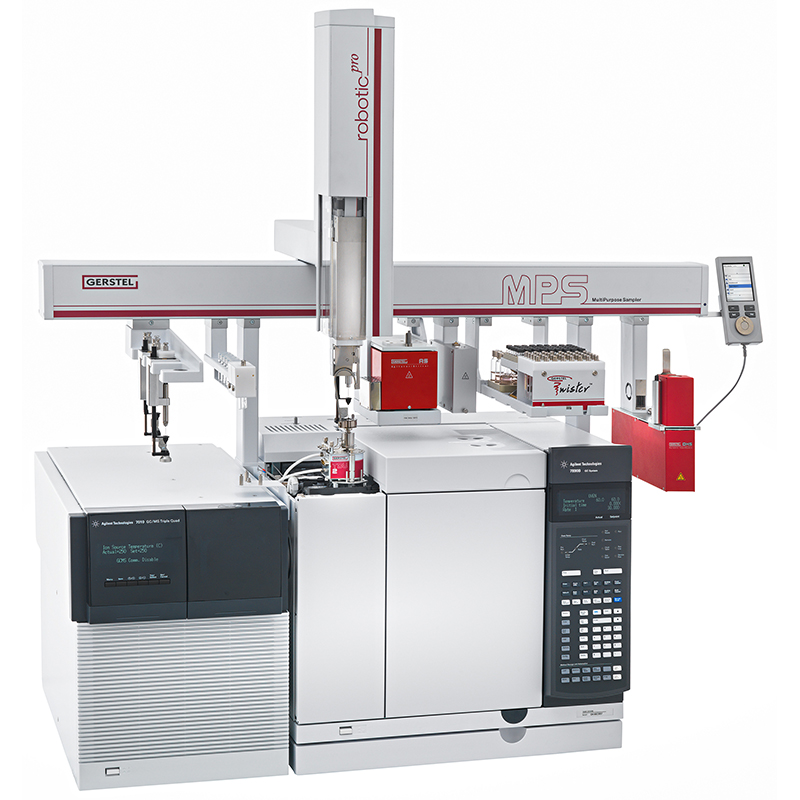Description
Adsorbent tubes used are stnadard GERSTEL Thermal Desorption Unit (TDU) tubes when using the standard DHS option or 3.5″ tubes when using DHS 3.5+ combined with the GERSTEL TD 3.5+ thermal desorber. Following analyte concentration, the tube is automatically transferred to the TDU or TD 3.5+ for Thermal Desorption and analyte transfer to the GC. Tubes are fitted with individual adapters enabling both automated movement and leak-free sealing during the Dynamic Headspace and Thermal Desorption steps and during storage in the autosampler tray.
Automated Dynamic Headspace combined with sample introduction to a GC or GC/MS system is performed by the MPS and TDU or TD 3.5+. More than 120 samples can be processed automatically in one sequence.
Dynamic Headspace Benefits:
- The GERSTEL Dynamic Headspace provides lower detection limits than static headspace, SPME and other widely used techniques
- High productivity through high throughput design and complete automation from sample preparation to GC/MS analysis
- Highest flexibility: User defined extraction time, flow, temperature and adsorbent
- The Dynamic Headspace technology provides multiple water management options to ensure best chromatography and MS stability
DHS – Powered By MAESTRO, DHS is easily and conveniently controlled from the GERSTEL MAESTRO Software.
Parallel processing of samples enable the DHS process to be performed during the chromatographic run of the preceding sample for optimal productivity and for highest system utilization.
Automated liquid handling in the MPS can be used for additional sample prep steps. As part of the sample prep procedure, standard addition can be performed automatically for best possible analytical results.
Sample prep steps are selected by mouse-click from a pull-down menu using the PrepBuilder function of the GERSTEL MAESTRO software.
A graphical scheduler display for the DHS process provides an overview of the time required for each individual step and for the complete sequence of samples for easier planning.
Just one method and one sequence table controls the complete process from DHS through sample prep and sample introduction to GC/MS analysis. Integrated control ensures a more efficient operation with less risk of error. The GERSTEL MAESTRO Software operates stand-alone or fully integrated with the Agilent Technologies ChemStation Software.
The DHS station provides sample thermostating and agitation combine with purging of the sample headspace with a controlled flow of inert gas. Extracted compounds are trapped and concentrated on a replaceable adsorbent-filled trap, which is subsequently thermally desorbed in the integrated Thermal Desorption Unit (TDU) followed by determination of the analytes using GC/MS. While in the GERSTEL MPS autosampler, samples are stored in standard headspace vials at ambient temperature. Optionally, samples can be stored at controlled temperatures between 4oC to 200oC.
During extraction, samples can be agitated to enhance and speed up the extraction process. The temperature of the adsorbent tube during the DHS process can be independently controlled from 20oC to 70oC for optimal trapping of the analytes of interest. The adsorbent tube can be dry purged for water removal to ensure the best possible chromatography and MS stability. A new adsorbent tube can be used for every sample, eliminating the risk of cross contamination or the same tube can be used for multiple samples as in standard Purge and Trap instruments.
Comparison of Gas Phase Extraction Techniques
Analysis of coffee powder using DHS, HS-SPME and Static Headspace
In order to compare different gas phase extraction techniques, 100 mg of samples of a ground coffee were analyzed using static headspace, headspace-SPME and DHS. Comparable extraction conditions were chosen.
It can be seen from the sample chromatograms and the bar graph showing relative peak areas (DHS response normalized to 100%), that DHS provided the highest response for the analytes that were determined.
For most analytes, DHS provided relative standard deviations well below 5%, which is equal to or better than the other techniques.
| HS | HS-SPME | DHS | |
|---|---|---|---|
| Temperature | 40oC | 40oC | 40oC |
| Extraction Time | 30min | 30min | 10min |
| Purge Flow | 20 ml/min | ||
| Adsorbent | DVB/Carboxen/PDMS | Tenax |






